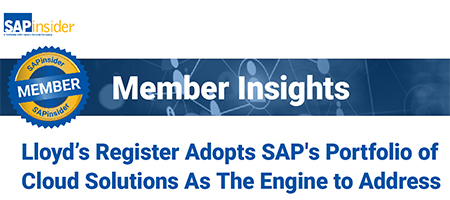Three Steps for Starting Your Cloud Journey
Partnership, Modernization, and Timeline
By Robert Holland, VP and Research Director, SAPinsider
Companies operating with on-premise SAP solutions are seeking a transition to the cloud for greater agility and flexibility. However, the move comes with several considerations regarding cost, security, and native toolset capabilities. Navigating this landscape requires a trusted partner with a strategy appropriate for the business.
A Good Partner is Necessary
To gain insight into cloud trends, SAPinsider sat down with Benjamin Calvo Cabet, Senior SAP Practice Manager in EMEA for Rackspace Technology. With the experience that Rackspace has a multi-cloud provider, Calvo Cabot offers important advice for organizations that are undergoing a cloud transformation.
Explore related questions
“I would say that around 90% of customers might have an idea, but don’t know the details of what they want to do,” says Calvo Cabet. “They are looking for help and providers that can help clarify the topic—especially with the SAP S/4HANA release, or when moving to the SAP HANA database as a first step.” There are many questions the customers have. What are the benefits of moving to the cloud? Is it a good idea to do everything at once? Or should they have multiple smaller projects that address different parts of the move and take that approach?
Having a partner that can help you navigate these questions is very important, and one of the things that Rackspace likes to do is show their clients the benefits of the cloud. For example, in a dashboard that indicates how the machine will look and be configured in a cloud environment. This allows organizations that are looking to gain a better understanding of what will happen should they decide to move some of their existing systems to the cloud.
But it is important that whoever you work with in your move to the cloud is looking to make that journey successful. “The specialty services that we provide and the focus on the customer is what differentiates Rackspace,” says Calvo Cabet. “We’re building our house on our quality service versus the quantity of implementations.” Having a partner who is experienced with cloud transformation is important, especially when the cloud transformation includes a move to SAP S/4HANA as well as a move to the cloud. But finding one that focuses on the quality of the result is also critical.”
Focus on Modernization not Digitization
According to Calvo Cabet, many organizations that come to Rackspace are being pushed by their management teams to modernize systems or digitalize their processes. But exactly what they’re looking for is often difficult to explain. Calvo Cabet thinks that instead of thinking about “digitalization” they should think about modernization and automation. Rackspace understands that not everything can be readily automated, but they emphasize that organizations should try and automate everything that can be automated.
This focus on modernization and automation is something that has also come up in SAPinsider research—particularly with the move to SAP S/4HANA, but it can be equally true with other transformation projects. But in order to automate as much as possible it’s necessary to reduce the number of customizations in a system. This is something that Calvo Cabet says Rackspace focuses on as well. “Automation is what we are trying to do with the customer. But they often face challenges of optimization because we want to standardize processes. Things like client copies, system copies, patching and other updates. This is what we want to automate, and we are automating with our customers so that they don’t know something is going on because it’s near zero downtime.”
It isn’t necessary to move to SAP S/4HANA to achieve this modernization though. Calvo Cabet says that Rackspace has customers coming from all releases, and many don’t want to move to SAP S/4HANA yet but may implement SAP HANA or switch to a different infrastructure so that they can be more flexible. “What we are really facing is that customers are interested answering the question on why they should move to the public cloud. And what does modernization mean for my business? For the processes, for my jobs, for whatever?” This is where performing a POC on a development system or something similar where it’s possible to see just how complex the migration is from a technical perspective.
A Timeline for Success
The key metrics that most organizations are tracking when considering a move to the cloud are budget and timeline. It is obvious that the cost of the move will always be a factor during the RFP process. But Calvo Cabet says that there are many times when customers come to them with a very accelerated timeline because they need to move from their existing provider because of a contract that is due to expire. This can leave organizations with less than twelve months to switch their entire SAP infrastructure. But it might also involve non-SAP systems and solutions or an entirely new service provider.
Experienced multi-cloud providers like Rackspace have been able to help their customers perform an accelerated adoption while also limiting the downtime. “We had a customer in Dubai where we did the modernization of SAP ECC 6.0 to SAP S/4HANA with just two hours of downtime on a Saturday,” said Calvo Cabet. “Everything in the project was tested prior to the cutover, but we went live in production on a new release.”
Organizations are looking for a partner that can help them meet these timeline and budget goals. In our 2021 SAP S/4HANA Migration Benchmark Report, one of the top requirements respondents had was that of a partner with a proven track record for implementing SAP S/4HANA. And the number one way in which respondents planned to use partners in their move was around optimizing workflows and processes, closely followed by business case and roadmap development. These are also topics that Calvo Cabet said that he is seeing from Rackspace customers.
What Does This Mean for SAPinsiders?
Digital transformation, moving to the cloud, or modernizing infrastructure. Each of these can be synonymous with moving to cloud-based deployments, whether you are doing a lift and shift with SAP ECC or moving to SAP S/4HANA. But how do you make that move successful?
- Find an experienced partner that will not only help you with the deployment but will help you understand what the move will look like for you. Many organizations use the same partner that they’ve used for years for much of their infrastructure or SAP work, but this partner may not be the most experienced when it comes to cloud implementations. “A good consultant will ask the right questions,” says Calvo Cabet. “What processes are they using? What does their SAP landscape look like? What are they looking to achieve from a process and application management point of view?” And an experienced partner will also be up-front about whether it makes sense to make that move.
- Understand what you want to accomplish with your transition by thoroughly mapping what you do today. According to customers that SAPinsider has interviewed, the most successful projects have started with a thorough evaluation of what their existing systems do in detail. From this they have created a deployment map that allows them to ensure that they are able to be successful in what they want to achieve. Whether you call it digitalization or modernization, taking the time to understand what you want to achieve before you start making any changes is critical to long-term success with your transformation project.
- Ensure that you understand your timeline and your budget so that you can focus on ensuring success. Part of choosing a good implementation partner is one that will help you understand what you can achieve within your budget and timeline. Not only in terms of determining whether it’s right to move to the cloud today, but what makes sense and what can be achieved. The public cloud may not be the best move right now, but it might make sense when additional services or features become available with a public cloud provider. Understanding that and having a partner who will help you understand what is best for you given your budget and timeline is critical.
About Rackspace Techn0logy
An SAP partner for over 20 years, Rackspace Technology is a multi-cloud technology services company. They work with their clients to design, build, and operate cloud environments across all cloud providers and technology platforms.








